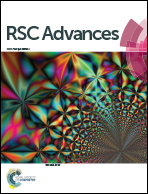The effect of the support structure on catalytic activity: a case study on hollow and solid MoO3/SiO2†
Abstract
Hollow and solid silica nanospheres inlaid with multiple MoO3 nanoclusters are obtained by a reverse microemulsion method. Characterization is carried out based on transmission electron microscopy (TEM), high-resolution transmission electron microscopy (HRTEM), X-ray photoelectron spectroscopy (XPS), inductively coupled plasma-optical emission spectrometry (ICP-OES) and N2 sorption measurements. Their catalytic activity towards acetalization of benzaldehyde was compared. The results showed that the hollow nanocomposite outperformed the solid counterpart. The enhancement of the hollow structure can be attributed to its bigger surface area, shorter pore channels and thus less travelling blockage.


 Please wait while we load your content...
Please wait while we load your content...